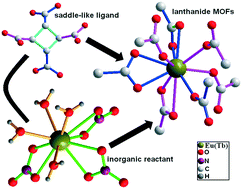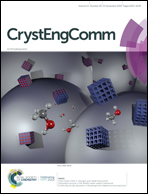Series of 3D lanthanide MOFs derived from saddle-like alicyclic tetracarboxylate ligands: synthesis, characterization and structure–photoluminescence correlations†
Abstract
In attempts to comprehend the structure–photoluminescence correlations of crystalline lanthanide metal–organic frameworks (LMOFs) assembled from alicyclic multicarboxylic acid ligands, eight new homo- and hetero-LMOFs formulated as [Ln(μ6-Hcbtc)(H2O)]n (Ln = Nd (Nd–Nd), Tb (Tb–Tb), cbtc = 1,2,3,4-cyclobutanetetracarboxylate anion), [Ln2(μ6-cbtc)(μ8-cbtc)0.5(H2O)]n (Ln = Tm (Tm–Tm), Yb (Yb–Yb)), [LnNa(μ9-cbtc)(H2O)]n (Ln = Pr (Pr-Na), Eu (Eu–Na), Tb (Tb–Na)) and [ErNa(μ6-cbtc) (μ2-H2O)(H2O)2·(H2O)]n (Er-Na) have been successfully synthesized. All of them were fully structurally characterized by elemental analyses, FT-IR spectra, powder X-ray diffraction and single-crystal X-ray diffraction techniques. Structural analysis reveals that various connecting modes between the saddle-like alicyclic tetracarboxylate linkers and the lanthanide (or lanthanide/sodium) ions generate four types of 3D LMOFs. Solid-state photoluminescence properties for the LMOFs Eu–Na, Tb–Tb, and Tb–Na as well as the inorganic reactants (lanthanide nitrate hexahydrates) [Ln(NO3)3(H2O)4·2(H2O)]n (Ln = Eu (Eu salt), Tb (Tb salt)) were investigated through the molecular imprint-tracking technique. Under direct excitation conditions, all the compounds exhibit characteristic photoluminescence based on 4f–4f transitions of the respective lanthanide ions, and different photoluminescence parameters (including the overall intensity of excitation and emission spectra, luminescence decay time and absolute quantum yield) are all comparatively discussed in detail. Based on the structure–photoluminescence correlations, compared with inorganic reactants, the less efficient energy transfer to OH vibrations caused by the absence of water molecules in the first coordination sphere of the Eu3+ (or Tb3+) ion results in much more intense photoluminescence for LMOFs. In particular, the maximum values of the solid-state absolute quantum yield for Eu–Na (37.16 ± 0.087%) and Tb–Na (47.26 ± 0.096%) render them better photoluminescent LMOFs. The studies also reveal that the semi-flexible alicyclic multicarboxylic acids can be used in the synthesis and assembly of functional LMOFs with highly efficient photoemitting characteristics.



 Please wait while we load your content...
Please wait while we load your content...